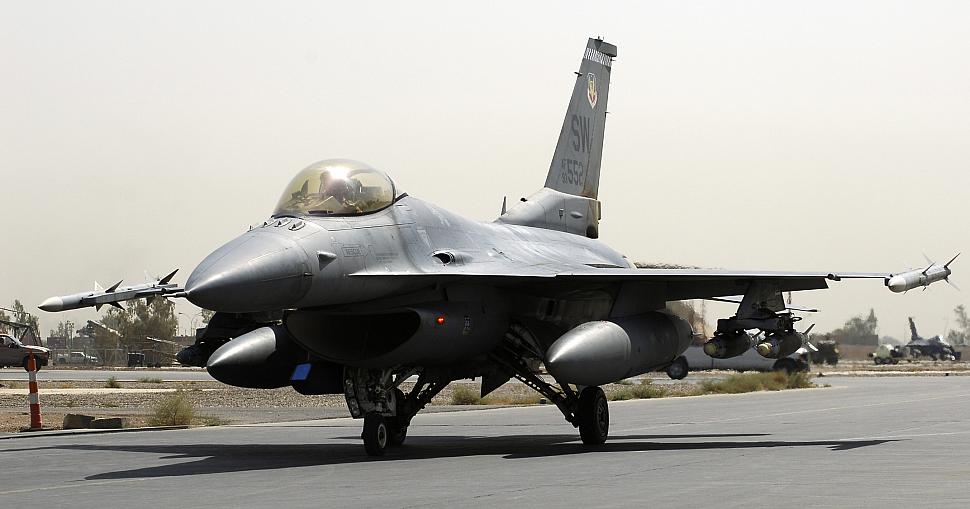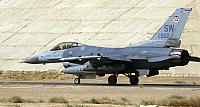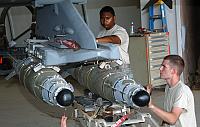Fighter Jet News
F-16 Fighting Falcon News
Balad F-16s unleash new weapon against mobile insurgent targets
August 27, 2008 (by
SSgt. Don Branum) -
Coalition air forces in Iraq unleashed a new precision guided weapon against anti-Iraqi forces August 12.

Two F-16 pilots with the 77th EFS executed the first-ever combat deployment of an GBU-54 Laser JDAM against a moving enemy vehicle in Diyala Province.
The GBU-54 is the U.S. Air Force's newest 500-pound precision weapon, equipped with a special targeting system that uses a combination of GPS and laser guidance to accurately engage and destroy moving targets.
"This employment first represents a great step in our Air Force's ability to deliver precise effects across the spectrum of combat," said Lt. Gen. Gary North, commander of U.S. Air Forces Central and U.S. Central Command Combined Force Air Component Commander. "The first combat employment of this weapon is the validation of the exacting hard work of an entire team of professionals who developed, tested and fielded this weapon on an extremely short timeline, based on an urgent needs request we established in the combat zone."
"We have consistently used precision-guided weapons to engage stationary threats with superb combat effects," said Brig. Gen. Brian Bishop, 332nd Air Expeditionary Wing commander. "This weapon allows our combat pilots to engage a broad range of moving targets with dramatically increased capabilities and it increases our ability to strike the enemy throughout a much, much broader engagement envelope."
The joint terminal attack controller who called in the airstrike is part of a military transition team supporting Iraqi army operations in Diyala, said Marine Maj. Robert Washington, 1st Iraqi Army Division MiTT fires adviser.
"From my perspective as an artilleryman, being able to hit a moving ground target is a great advantage -- especially with insurgents using vehicles to escape quickly once they're identified," said Major Washington, who manages all aspects of fire support for the 1st IA Division MiTT, including artillery, mortars and air support. "Any improvement we can get is a big one."
The pilots who employed the GBU-54 are captains deployed from Shaw Air Force Base, S.C. They have flown a combined 1,360 hours in F-16s with more than 400 combined combat hours. Their identities were withheld for operational security reasons.
Both pilots have to work together closely to successfully employ the GBU-54. "It's a complicated weapon to employ: it takes two people backing each other up and making sure the weapon is employed properly," one of the pilots said.
Both considered the historic significance of their successful mission.
"I thought it was a really rewarding part of being history, in a sense, when you consider the evolution of precision guided weapons," the second pilot said.
That evolution has allowed the Air Force to employ weapons proportionately to the enemy threat, said Col. Michael Fantini, 332nd Expeditionary Operations Group commander.
"Precision's a big deal," he said. "In World War II, it took a lot of bombs to take out a target due to (low) accuracy. If I don't have accuracy, I need more bombs.
"Now, the fact that we can nearly always put one weapon against one target means we need less ordnance to destroy a target and less air power to put against a threat to achieve a desired effect," he said. "That translates to less exposure to the threat environment and a higher probability of killing targets." It also minimizes collateral damage, a critical consideration in winning the peace.
Teamwork in all aspects from development to the actual weapon employment was crucial, General North said.
"Teamwork was the name of the game to accomplish this," he said. "From the experts in our Air Force Materiel Command who shaped our requirements, then developed, tested and fielded the weapon, to our aircraft maintainers, our munitions Airmen, and weapons loaders ... and everyone in between ... they made the operational employment of this weapon possible.
"At endgame, on Aug. 12, the team of the U.S. Air Force joint terminal attack controller, alongside his ground unit commander in this event, ensured all criteria were met for the first combat delivery of the LJDAM. And finally, our F-16 pilot accurately and precisely delivered and guided the weapon to desired weapons effects, the disabling and destruction of an enemy vehicle and personnel," he said.
Development of the weapon began in January 2007 as an urgent operational need request, said Lt. Col. David Lujan, 332nd Expeditionary Operations Group deputy commander. Colonel Lujan was the program management officer for the GBU-54's development while commanding the 86th Fighter Weapons Squadron at Eglin AFB, Fla. The 86th FWS tests precision guided munitions for the Air Force.
"Around 2006, warfighters started to ask us for better capabilities against movers," said Colonel Lujan, who is deployed from Luke AFB, Ariz. "Boeing came up with the idea of putting the laser kit on the GBU-38, and we pitched it to the Air Force under an urgent operational need request."
The Air Force made the 86th FWS' request a top priority, moving the GBU-54 through the development and testing cycle in less than 17 months, fielding the bombs aboard 332nd Air Expeditionary Wing F-16s in May.

USAF F-16C block 50 #93-0552 from the 55th FS, piloted by Capt. Michael Lutmer and loaded with 500-pound GBU-54 Laser Joint Direct Attack Munitions, taxies toward a runway at Balad AB on August 15th, 2008. Two F-16 pilots with the 77th EFS executed the first-ever combat employment of a GBU-54 on August 12th against a moving enemy vehicle in Diyala province to support a combined Iraqi army and U.S. Marine operation. [USAF photo by SSgt. Don Branum]
The GBU-54 is the U.S. Air Force's newest 500-pound precision weapon, equipped with a special targeting system that uses a combination of GPS and laser guidance to accurately engage and destroy moving targets.
"This employment first represents a great step in our Air Force's ability to deliver precise effects across the spectrum of combat," said Lt. Gen. Gary North, commander of U.S. Air Forces Central and U.S. Central Command Combined Force Air Component Commander. "The first combat employment of this weapon is the validation of the exacting hard work of an entire team of professionals who developed, tested and fielded this weapon on an extremely short timeline, based on an urgent needs request we established in the combat zone."
"We have consistently used precision-guided weapons to engage stationary threats with superb combat effects," said Brig. Gen. Brian Bishop, 332nd Air Expeditionary Wing commander. "This weapon allows our combat pilots to engage a broad range of moving targets with dramatically increased capabilities and it increases our ability to strike the enemy throughout a much, much broader engagement envelope."
The joint terminal attack controller who called in the airstrike is part of a military transition team supporting Iraqi army operations in Diyala, said Marine Maj. Robert Washington, 1st Iraqi Army Division MiTT fires adviser.
"From my perspective as an artilleryman, being able to hit a moving ground target is a great advantage -- especially with insurgents using vehicles to escape quickly once they're identified," said Major Washington, who manages all aspects of fire support for the 1st IA Division MiTT, including artillery, mortars and air support. "Any improvement we can get is a big one."
The pilots who employed the GBU-54 are captains deployed from Shaw Air Force Base, S.C. They have flown a combined 1,360 hours in F-16s with more than 400 combined combat hours. Their identities were withheld for operational security reasons.
Both pilots have to work together closely to successfully employ the GBU-54. "It's a complicated weapon to employ: it takes two people backing each other up and making sure the weapon is employed properly," one of the pilots said.
Both considered the historic significance of their successful mission.
"I thought it was a really rewarding part of being history, in a sense, when you consider the evolution of precision guided weapons," the second pilot said.
That evolution has allowed the Air Force to employ weapons proportionately to the enemy threat, said Col. Michael Fantini, 332nd Expeditionary Operations Group commander.
"Precision's a big deal," he said. "In World War II, it took a lot of bombs to take out a target due to (low) accuracy. If I don't have accuracy, I need more bombs.
"Now, the fact that we can nearly always put one weapon against one target means we need less ordnance to destroy a target and less air power to put against a threat to achieve a desired effect," he said. "That translates to less exposure to the threat environment and a higher probability of killing targets." It also minimizes collateral damage, a critical consideration in winning the peace.
Teamwork in all aspects from development to the actual weapon employment was crucial, General North said.
"Teamwork was the name of the game to accomplish this," he said. "From the experts in our Air Force Materiel Command who shaped our requirements, then developed, tested and fielded the weapon, to our aircraft maintainers, our munitions Airmen, and weapons loaders ... and everyone in between ... they made the operational employment of this weapon possible.
"At endgame, on Aug. 12, the team of the U.S. Air Force joint terminal attack controller, alongside his ground unit commander in this event, ensured all criteria were met for the first combat delivery of the LJDAM. And finally, our F-16 pilot accurately and precisely delivered and guided the weapon to desired weapons effects, the disabling and destruction of an enemy vehicle and personnel," he said.
Development of the weapon began in January 2007 as an urgent operational need request, said Lt. Col. David Lujan, 332nd Expeditionary Operations Group deputy commander. Colonel Lujan was the program management officer for the GBU-54's development while commanding the 86th Fighter Weapons Squadron at Eglin AFB, Fla. The 86th FWS tests precision guided munitions for the Air Force.
"Around 2006, warfighters started to ask us for better capabilities against movers," said Colonel Lujan, who is deployed from Luke AFB, Ariz. "Boeing came up with the idea of putting the laser kit on the GBU-38, and we pitched it to the Air Force under an urgent operational need request."
The Air Force made the 86th FWS' request a top priority, moving the GBU-54 through the development and testing cycle in less than 17 months, fielding the bombs aboard 332nd Air Expeditionary Wing F-16s in May.
Courtesy 332nd Air Expeditionary Wing Public Affairs
Additional images:




USAF F-16C block 50 #93-0552 from the 55th FS, piloted by Capt. Michael Lutmer and loaded with 500-pound GBU-54 Laser Joint Direct Attack Munitions, taxies toward a runway at Balad AB on August 15th, 2008. Two F-16 pilots with the 77th EFS executed the first-ever combat employment of a GBU-54 on August 12th against a moving enemy vehicle in Diyala province to support a combined Iraqi army and U.S. Marine operation. [USAF photo by SSgt. Don Branum]

USAF F-16C block 50 #93-0552 from the 55th FS, piloted by Capt. Michael Lutmer and loaded with 500-pound GBU-54 Laser Joint Direct Attack Munitions, awaits clearance to take off from Balad AB on August 15th, 2008. Two F-16 pilots with the 77th EFS executed the first-ever combat employment of a GBU-54 on August 12th against a moving enemy vehicle in Diyala province to support a combined Iraqi army and U.S. Marine operation. [USAF photo by A1C. Jason Epley]

SSgts. Michael Jackson and Anthony Bagen align a 500-pound GBU-54 Laser Joint Direct Attack Munition before connecting it to an F-16C at Balad AB on August 14th, 2008. Two F-16 pilots with the 77th EFS executed the first-ever combat employment of a GBU-54 on August 12th against a moving enemy vehicle in Diyala province to support a combined Iraqi army and USMC operation. Sgt. Bagen is a weapons load crew chief, Sgt. Jackson is a weapons load crewmember. [USAF photo by TSgt. Erik Gudmundson]
Related articles:
Forum discussion:
Tags
- ACC F-16s start using 500lbs GBU-38 JDAM at Balad AB (2004-11-04)
- Denmark first in Europe to drop GPS-guided GBU-31 JDAM from F-16 (2004-04-05)
- F-16 Fighting Falcon news archive
Forum discussion:
Tags
